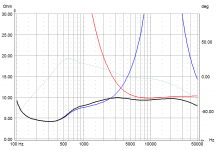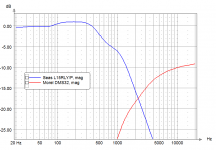New Visaton waveguide WG148R with Morel DMS30s
Hi guys.
I've been listening these for some time now so here they are. My first job as a teenager was at speaker repair shop. It was not by accident - while i was at high school i went there and asked if i can work there for the summer. The owner laughed and said that i should come next summer if i'm really that interested. And so i have. Anyways, there were lots of crappy loudspeakers there but quite a few good ones as well. There and then i tried the same tweeters with and without ferrofluid and noticed that ferrofluid lowers Fs, cools down the voice coil but at the expense of some fine micro-details. In the past 15 years i totally forgot about it until recently - when i guy i now sent me a pic of D2608/913 opened and said that the ferrofluid was taken out. I immediately started thinking when will i have some time to do the check if it can be done safely with my Morel DMS30S. Two weeks ago (while kids were sleeping and wife reading) i managed to do it. As ferrofluid can be bought on ebay these days, what is the worst thing that can happen - to change the old ferrofluid?
Getting it out was a fairly easy task but with certain level of caution and care while opening it. Simple peace of toilet paper was enough to soak the ferrofluid from the magnetic gap. I had a problem of one tweeter being slightly less sensitive than the other. When i opened it it was obvious that one tweeter had healthy amount of FF but the other not so much. It could evaporate a little during time and maybe thickened a little bit. Anyways, here are the measurements before and after removing the ferrofluid from the gap.

https://s7.postimg.cc/ewppsy4u3/image.png
 https://s7.postimg.cc/yekd8vu23/image.png
https://s7.postimg.cc/yekd8vu23/image.png
 https://s7.postimg.cc/mcozer097/image.png
https://s7.postimg.cc/mcozer097/image.png
What was the result of this stunt ? It was clear after first few tones that it is better. The only way to explain is that metal instruments started to sound metallic. The details appeared. Seas makes tweeters for German market with prefix NoFerro and of course without ferrofluid - and for a good reason i guess. Not that i think that all tweeters are better without ferrofluid - but there is something to it. It was also clear, after the first few tones, that the crossover i made before was nothing less than obsolete or a good starting point for a new one. The tweeters started to measure the same, sensitivity wise. So few changes are in order and it lead to next few measurements.
On axis
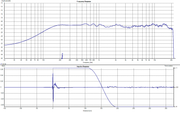
https://s7.postimg.cc/4dpq3jp8r/na_osi_1.png
On axis, 1dB grid

https://s7.postimg.cc/r7e2zc6mz/image.png
Reversed phase

https://s7.postimg.cc/4iovzr9tn/image.png
Individual driver response 5dB grid

https://s7.postimg.cc/ue8mixgsb/image.png
Individual driver response 2dB grid

https://s7.postimg.cc/o0jjfnwgr/image.png
Off axis 1
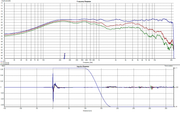
https://s13.postimg.cc/kzlqpm0x3/van_ose_1.png
Off axis 2

https://s13.postimg.cc/ka2yd983b/van_ose_2.png
Measurement at 1m vs 2m distance

https://s7.postimg.cc/w61ldv2q3/1_2.png
All measurements are done from 1m distance except the last one that serves just to see if the response changes significantly. There are measurements on axis, off axis 90 degrees and everything in between is - well somewhere in between. I didn't make the jig to see at what angles exactly i'm measuring it - it serves me to see that there is slight blooming at 3.5KHz but not too bad. They all are over 50deg - from 0-45 they look ridiculously good. Slight blooming at 3.5KHz is the reason i didn't want to sort out the slight 1dB dip on axis at 3.5KHz - i think it will make for nice and flat power response. Tweeter and midwoofer slopes measures nice but there is that picture that shows hash over 8KHz i'm not too proud of and it is dealt with slightly different tank filter but i didn't get to make measurements. In a few days i'll post them here. That would be my graphs for now with all of their highs and lows.
Crossover

https://s9.postimg.cc/kjbek5bvj/image.jpg
Distortion for L15RLY
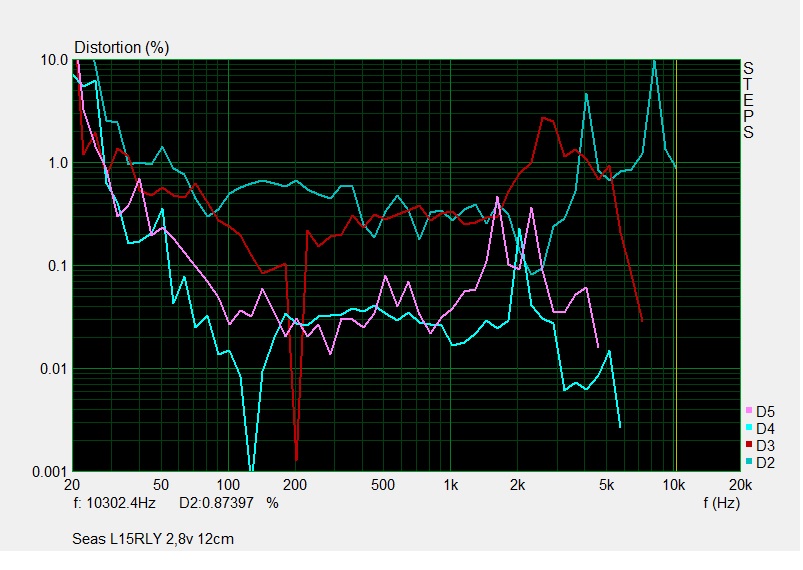
Burst decay for L15RLY
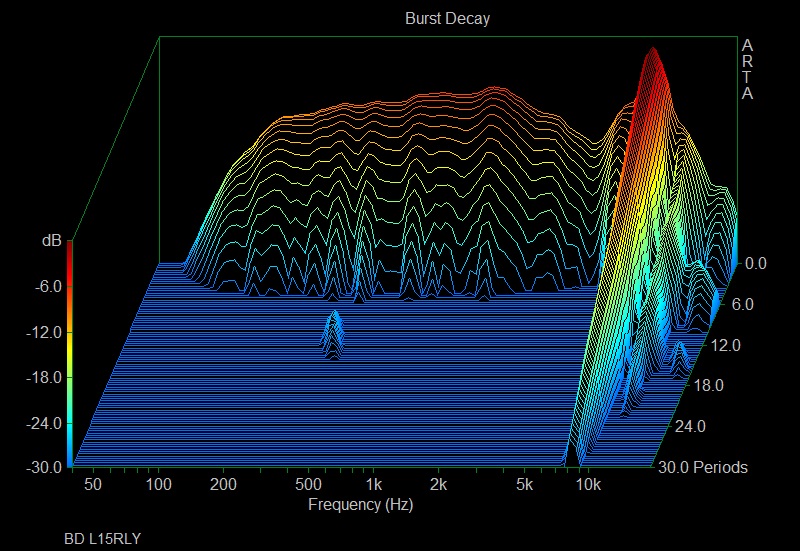
Mounting the tweeter on the waveguide:

https://s1.postimg.cc/6go01gszj/DSC_0020.jpg

https://s1.postimg.cc/fe8pytlfj/DSC_0015.jpg

https://s1.postimg.cc/uggcvrglb/DSC_0011.jpg

https://s1.postimg.cc/gbf57owxr/DSC_0012.jpg

https://s1.postimg.cc/k92ex3jr3/DSC_0013.jpg
Test cabinets

https://s9.postimg.cc/w2qi79inz/attachment.jpg

https://s24.postimg.cc/utmj3ffph/DSC_0010.jpg
Finished cabinets:
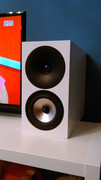
https://s1.postimg.cc/1hm0ml7nen/Seas_5.jpg
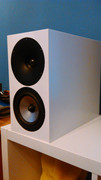
https://s1.postimg.cc/5bus5jry7j/Seas_6.jpg

https://s1.postimg.cc/7pa60x1c5b/Seas_7.jpg
I added piece of pipe at the inner end of Visaton BR19.24 bass reflex tube. My measured impedance of finished loudspeaker says that Fb is 45Hz.
Volume of my loudspeaker cabinet is 13.6 liters without tube and volume occupied by drivers and damping material. If i ever use them with subs, i'll put them in smaller closed cabinets.
Pretty low xover point made the breakup quite irrelevant. They sound great to me but (unless used with subs) they are not for large rooms. Mine is about 20sq meters. I was in a bit of dilemma - should i post this or not. Zaph removed the project that uses L15 midwoofer from his website because of his ZA14 two way saying that at the price of this midwoofer there are better options these days. Maybe he is right but i recently built a two way using SB17NRXC35-8 and SB29RDC-C0004. While the tweeter sounds great, SB17 just doesn't. I don't care how much lower the distortion is in SB17 compared to L15 but Seas sounds much much better. SB goes deeper ofc, but Seas has more articulate bass, more detailed and precise midrange. Both have similar (1700Hz was for SB drivers) xover frequency but the little Seas is much better in almost every aspect. So, even SB17 is cheaper and measures better regarding distortion and is quite popular these days, it sounds worse and that is one of the reasons i posted this project. I don't expect people to buy this midwoofer just to make this but if you bought it long time ago (like i did) for whatever reason and it sits unused somewhere, you should try this. You just might be surprised.
EDIT:
New vs old crossover for midwoofer:
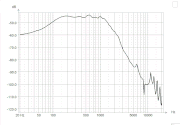
https://s14.postimg.cc/569ci9n9t/output_7wt_Dw_K.gif
Hi guys.
I've been listening these for some time now so here they are. My first job as a teenager was at speaker repair shop. It was not by accident - while i was at high school i went there and asked if i can work there for the summer. The owner laughed and said that i should come next summer if i'm really that interested. And so i have. Anyways, there were lots of crappy loudspeakers there but quite a few good ones as well. There and then i tried the same tweeters with and without ferrofluid and noticed that ferrofluid lowers Fs, cools down the voice coil but at the expense of some fine micro-details. In the past 15 years i totally forgot about it until recently - when i guy i now sent me a pic of D2608/913 opened and said that the ferrofluid was taken out. I immediately started thinking when will i have some time to do the check if it can be done safely with my Morel DMS30S. Two weeks ago (while kids were sleeping and wife reading) i managed to do it. As ferrofluid can be bought on ebay these days, what is the worst thing that can happen - to change the old ferrofluid?
Getting it out was a fairly easy task but with certain level of caution and care while opening it. Simple peace of toilet paper was enough to soak the ferrofluid from the magnetic gap. I had a problem of one tweeter being slightly less sensitive than the other. When i opened it it was obvious that one tweeter had healthy amount of FF but the other not so much. It could evaporate a little during time and maybe thickened a little bit. Anyways, here are the measurements before and after removing the ferrofluid from the gap.

https://s7.postimg.cc/ewppsy4u3/image.png
 https://s7.postimg.cc/yekd8vu23/image.png
https://s7.postimg.cc/yekd8vu23/image.png https://s7.postimg.cc/mcozer097/image.png
https://s7.postimg.cc/mcozer097/image.pngWhat was the result of this stunt ? It was clear after first few tones that it is better. The only way to explain is that metal instruments started to sound metallic. The details appeared. Seas makes tweeters for German market with prefix NoFerro and of course without ferrofluid - and for a good reason i guess. Not that i think that all tweeters are better without ferrofluid - but there is something to it. It was also clear, after the first few tones, that the crossover i made before was nothing less than obsolete or a good starting point for a new one. The tweeters started to measure the same, sensitivity wise. So few changes are in order and it lead to next few measurements.
On axis

https://s7.postimg.cc/4dpq3jp8r/na_osi_1.png
On axis, 1dB grid

https://s7.postimg.cc/r7e2zc6mz/image.png
Reversed phase

https://s7.postimg.cc/4iovzr9tn/image.png
Individual driver response 5dB grid

https://s7.postimg.cc/ue8mixgsb/image.png
Individual driver response 2dB grid

https://s7.postimg.cc/o0jjfnwgr/image.png
Off axis 1

https://s13.postimg.cc/kzlqpm0x3/van_ose_1.png
Off axis 2

https://s13.postimg.cc/ka2yd983b/van_ose_2.png
Measurement at 1m vs 2m distance

https://s7.postimg.cc/w61ldv2q3/1_2.png
All measurements are done from 1m distance except the last one that serves just to see if the response changes significantly. There are measurements on axis, off axis 90 degrees and everything in between is - well somewhere in between. I didn't make the jig to see at what angles exactly i'm measuring it - it serves me to see that there is slight blooming at 3.5KHz but not too bad. They all are over 50deg - from 0-45 they look ridiculously good. Slight blooming at 3.5KHz is the reason i didn't want to sort out the slight 1dB dip on axis at 3.5KHz - i think it will make for nice and flat power response. Tweeter and midwoofer slopes measures nice but there is that picture that shows hash over 8KHz i'm not too proud of and it is dealt with slightly different tank filter but i didn't get to make measurements. In a few days i'll post them here. That would be my graphs for now with all of their highs and lows.
Crossover

https://s9.postimg.cc/kjbek5bvj/image.jpg
Distortion for L15RLY

Burst decay for L15RLY

Mounting the tweeter on the waveguide:

https://s1.postimg.cc/6go01gszj/DSC_0020.jpg

https://s1.postimg.cc/fe8pytlfj/DSC_0015.jpg

https://s1.postimg.cc/uggcvrglb/DSC_0011.jpg

https://s1.postimg.cc/gbf57owxr/DSC_0012.jpg

https://s1.postimg.cc/k92ex3jr3/DSC_0013.jpg
Test cabinets

https://s9.postimg.cc/w2qi79inz/attachment.jpg

https://s24.postimg.cc/utmj3ffph/DSC_0010.jpg
Finished cabinets:

https://s1.postimg.cc/1hm0ml7nen/Seas_5.jpg

https://s1.postimg.cc/5bus5jry7j/Seas_6.jpg

https://s1.postimg.cc/7pa60x1c5b/Seas_7.jpg
I added piece of pipe at the inner end of Visaton BR19.24 bass reflex tube. My measured impedance of finished loudspeaker says that Fb is 45Hz.
Volume of my loudspeaker cabinet is 13.6 liters without tube and volume occupied by drivers and damping material. If i ever use them with subs, i'll put them in smaller closed cabinets.
Pretty low xover point made the breakup quite irrelevant. They sound great to me but (unless used with subs) they are not for large rooms. Mine is about 20sq meters. I was in a bit of dilemma - should i post this or not. Zaph removed the project that uses L15 midwoofer from his website because of his ZA14 two way saying that at the price of this midwoofer there are better options these days. Maybe he is right but i recently built a two way using SB17NRXC35-8 and SB29RDC-C0004. While the tweeter sounds great, SB17 just doesn't. I don't care how much lower the distortion is in SB17 compared to L15 but Seas sounds much much better. SB goes deeper ofc, but Seas has more articulate bass, more detailed and precise midrange. Both have similar (1700Hz was for SB drivers) xover frequency but the little Seas is much better in almost every aspect. So, even SB17 is cheaper and measures better regarding distortion and is quite popular these days, it sounds worse and that is one of the reasons i posted this project. I don't expect people to buy this midwoofer just to make this but if you bought it long time ago (like i did) for whatever reason and it sits unused somewhere, you should try this. You just might be surprised.
EDIT:
New vs old crossover for midwoofer:

https://s14.postimg.cc/569ci9n9t/output_7wt_Dw_K.gif
Last edited:
Very nice project. And beautiful execution too.
I have the same positive opinion about "no-ferro" tweeters and am in agreement with you. Ditto for the wg.
This is not a critique, but I am interested in your opinion/experience with the impedance peak flattening on such tweeters. As measured, the Morel rose up to 14/15 Ohms at 1100 Hz (the one I use peaks to 25 Ohms at 660) and your xo is at about 1600 or so. The graphs are as clean as could be, but have you tried the imp peak eq? Like I said, not challenging, just genuinely curious. I think I can differentiate with/without, but then only at higher volume levels than I listen to normally. The peak could add ringing, even though it won't show on (FR) measurements. It does show on the distortion measurements. So FWIF, I am using it, at least for a piece of mind.
I have the same positive opinion about "no-ferro" tweeters and am in agreement with you. Ditto for the wg.
This is not a critique, but I am interested in your opinion/experience with the impedance peak flattening on such tweeters. As measured, the Morel rose up to 14/15 Ohms at 1100 Hz (the one I use peaks to 25 Ohms at 660) and your xo is at about 1600 or so. The graphs are as clean as could be, but have you tried the imp peak eq? Like I said, not challenging, just genuinely curious. I think I can differentiate with/without, but then only at higher volume levels than I listen to normally. The peak could add ringing, even though it won't show on (FR) measurements. It does show on the distortion measurements. So FWIF, I am using it, at least for a piece of mind.
Hi Draki,
Thanks for kind words.
There is an impedance peak eq - L4-C5-R8. These are simulated impedance and transfer function of the system.
https://s13.postimg.org/aqsunwy4n/image.png
https://s13.postimg.org/4fnn7rcef/e_e.png
Thanks for kind words.
There is an impedance peak eq - L4-C5-R8. These are simulated impedance and transfer function of the system.
An externally hosted image should be here but it was not working when we last tested it.
https://s13.postimg.org/aqsunwy4n/image.png
An externally hosted image should be here but it was not working when we last tested it.
https://s13.postimg.org/4fnn7rcef/e_e.png
Last edited:
Here are some more measurements.
Old vs new tank filter. Now all of the hash is -30dB or more with respect to fundament. It can be done -40dB but at the expense of one more notch filter. Since i listen about 30 degrees off axis, as waveguide loaded speakers should, it is more then enough to sound great.
https://s10.postimg.org/xz61c9bqh/image.png
https://s10.postimg.org/ki92tdtp5/image.png
In a few days i'll measure impedance to confirm the simulation - but that is almost always correct.
Old vs new tank filter. Now all of the hash is -30dB or more with respect to fundament. It can be done -40dB but at the expense of one more notch filter. Since i listen about 30 degrees off axis, as waveguide loaded speakers should, it is more then enough to sound great.
An externally hosted image should be here but it was not working when we last tested it.
https://s10.postimg.org/xz61c9bqh/image.png
An externally hosted image should be here but it was not working when we last tested it.
https://s10.postimg.org/ki92tdtp5/image.png
In a few days i'll measure impedance to confirm the simulation - but that is almost always correct.
Hello Zvu,
I make a duet with Drake about your work😄 Have you measured distortion after implementing the notch. In my AL170, the 3rd and 5th order is substantially decreased when notching out cone breakup...
One thing I don't understand about this low x-over, with such a small midbass, are polar responses matched between drivers?
Merry x-mas!
I make a duet with Drake about your work😄 Have you measured distortion after implementing the notch. In my AL170, the 3rd and 5th order is substantially decreased when notching out cone breakup...
One thing I don't understand about this low x-over, with such a small midbass, are polar responses matched between drivers?
Merry x-mas!
Hello Zvu,
I make a duet with Drake about your work�� Have you measured distortion after implementing the notch. In my AL170, the 3rd and 5th order is substantially decreased when notching out cone breakup...
One thing I don't understand about this low x-over, with such a small midbass, are polar responses matched between drivers?
Merry x-mas!
Merry Christmas to you to Peter,
I haven't done any distortion measurements after implementing the crossover. I'm having a bit of a problem with my current notebook when measuring distortion that i have to sort out.
If i understand you correctly - you measured distortion for your driver without notch filter. Then you added notch filter (notch being centered at the cone breakup) and as a result the 3rd and 5th harmonic decreased lower in frequency ?
If that is the case, i'd really like to see those measurements - before and after.
In short - i have controlled directivity from about 2.2KHz - lower than that it widens. So yes, they are matched but they are both wide at crossover frequency - as can be seen from off axis measurements. As for low xover - i had to make it low because i didn't like 3rd order spike at 2.7KHz and 5th order spike reaches the 3rd at 1620Hz so i made that one of the design goals. Point of low xover is to avoid the distortion jump that is inherent to the driver itself. If i used different midbass driver (one that has low distortion, no breakup and flat frequency response up to at least 5-6KHz), i could make the crossover point a bit higher (between 2-3KHz) and use increasing directivity of midbass to tailor off axis response to my own need and preference. Morel is quite powerful tweeter and it can take low crossover point - with this Visaton waveguide it is at 2300Hz electrically.
Very nice looking speakers and well done! Have you investigated the 3rd harmonic rise at around 3Khz? Merry Christmas!
Hi Mario,
Thanks for kind words.
3rd harmonic peak at 2700Hz is a product of cone breakup at 8100Hz and 5th is at 1620Hz - so there isn't much to investigate. Reason is known and the only way to mitigate it is to make the crossover point at that frequency or lower.
Last edited:
Zvu,
I buillt the Visamon 170 from HobbyHi-fi, but with active crossover. I'm not at home right now, so can't send any measurements from Hobby Hi-fi + I don't have any possibilities to make measurements, but it make sense that if resonances are decreased by notches, distortion goes down. At least if resonances is corresponding to them....
Peter
I buillt the Visamon 170 from HobbyHi-fi, but with active crossover. I'm not at home right now, so can't send any measurements from Hobby Hi-fi + I don't have any possibilities to make measurements, but it make sense that if resonances are decreased by notches, distortion goes down. At least if resonances is corresponding to them....
Peter
Zvu,
I buillt the Visamon 170 from HobbyHi-fi, but with active crossover. I'm not at home right now, so can't send any measurements from Hobby Hi-fi + I don't have any possibilities to make measurements, but it make sense that if resonances are decreased by notches, distortion goes down. At least if resonances is corresponding to them....
Peter
Unfortunately, it doesn't work that way.
If you notch out the resonance peak, it decreases the distortion at that particular frequency where the notch is - for as much decibels as the fundament. 3rd and 5th distortion peaks lower in frequency, that are product of that breakup, remains and must be dealt separately at that particular frequency.
I have quite a few HobbyHifi magazines. Do you happen to know what year and month is it, or the name of project you've made ? Thanks
Last edited:
...name of kit is Visamon 170 and I'm pretty confident they are right. HobbyHi-fi claims when x-over is done correctly, it will reduce distortion and their measurements shows that. Black and white is enough for me at the moment, anyone that can disprove it is welcome😊
Peter
Peter
...name of kit is Visamon 170 and I'm pretty confident they are right. HobbyHi-fi claims when x-over is done correctly, it will reduce distortion and their measurements shows that. Black and white is enough for me at the moment, anyone that can disprove it is welcome��
Peter
The project name is Visamon 170. The only version i managed to find is passive. There it is:
Hobby Hifi Visaton Visamon 170 - Speaker KIT without Cabinet Standard kaufen bei hifisound.de
.jpg)
Now, the crossover frequency is 2100Hz. That means that someone smart made the crossover for it because from 2KHz to 3KHz there is a large distortion peak. Making 2100 crossover point and quite sharp slope is wise. Here is the pic for distortion measurement from K&T
An externally hosted image should be here but it was not working when we last tested it.
https://s10.postimg.org/6uhvu327t/o_170.png
I can only assume that active version follows the same premises. So, i don't see what is wrong with what i said and what is it that i should disprove ?
Last edited:
...the measurement from klang+ton is totally different. HobbyHi-fi has raw driver and filtered response in same setup and more detailed graphs than klang...
There is no active version published, I've made one myself. I can send you passive article when I'm back home in January...
There is no active version published, I've made one myself. I can send you passive article when I'm back home in January...
I know that the measurement from Klang&Ton is different but it makes more sense than HobbyHifi in this case.
Allow me to explain...
Here is example of distortion mesurements for L16RNX from K&T and Hobby-Hifi. While we can not compare levels of distortion, we can compare general trends of distortion.
L16RNX frequency response:

K&T distortion measurements:
Hobbyhifi measurements:
Now, since there is cone breakup at 5KHz at measurements (factory, KT and HobbyHifi all measured it correct) there will be 3rd harmonic peak at roughly 1666Hz and 5th harmonic peak at 1000Hz. K&T shows only HD2 and HD3 so there is quite visible peak of HD3 at that frequency. Hobby-Hifi on the other hand shows 2nd, 3rd and 5th - and while there are no peak at 1666Hz on 3rd harmonic, there is quite visible peak at 1000Hz on 5th harmonic. If breakup propagates as 5th harmonic, it will as 3rd harmonic also. All of that means that it failed to show real picture somehow or HobbyHifi measures different kind of L16RNX than everyone else (since similar distortion profile to K&T is visible in Zaphs measurements).
Now, back on AL170 - that is the same thing. They show quite benign distortion profile, while reality is different. Here is measured distortion from an independent party:
3rd distortion peak is quite visible there too so it makes measurements of K&T much more reliable than Hobby Hifi in this case.
This is not to say that all distortion measurements from HobbyHiFi are bad - these are exceptions because in most cases they measure it properly, but every once in a while they don't. I don't know the reasons for it, it just is.
As for distortion behaviour when you notch out the resonance peak - you'll just have to believe me that peak in HD3 at 2KHz will not disappear when you put notch filter on 6KHz cone resonance and flatten it out. Or not
Merry Christmas
Allow me to explain...
Here is example of distortion mesurements for L16RNX from K&T and Hobby-Hifi. While we can not compare levels of distortion, we can compare general trends of distortion.
L16RNX frequency response:

K&T distortion measurements:
An externally hosted image should be here but it was not working when we last tested it.
Hobbyhifi measurements:
An externally hosted image should be here but it was not working when we last tested it.
Now, since there is cone breakup at 5KHz at measurements (factory, KT and HobbyHifi all measured it correct) there will be 3rd harmonic peak at roughly 1666Hz and 5th harmonic peak at 1000Hz. K&T shows only HD2 and HD3 so there is quite visible peak of HD3 at that frequency. Hobby-Hifi on the other hand shows 2nd, 3rd and 5th - and while there are no peak at 1666Hz on 3rd harmonic, there is quite visible peak at 1000Hz on 5th harmonic. If breakup propagates as 5th harmonic, it will as 3rd harmonic also. All of that means that it failed to show real picture somehow or HobbyHifi measures different kind of L16RNX than everyone else (since similar distortion profile to K&T is visible in Zaphs measurements).
Now, back on AL170 - that is the same thing. They show quite benign distortion profile, while reality is different. Here is measured distortion from an independent party:
An externally hosted image should be here but it was not working when we last tested it.
3rd distortion peak is quite visible there too so it makes measurements of K&T much more reliable than Hobby Hifi in this case.
This is not to say that all distortion measurements from HobbyHiFi are bad - these are exceptions because in most cases they measure it properly, but every once in a while they don't. I don't know the reasons for it, it just is.
As for distortion behaviour when you notch out the resonance peak - you'll just have to believe me that peak in HD3 at 2KHz will not disappear when you put notch filter on 6KHz cone resonance and flatten it out. Or not
Merry Christmas
Last edited:
I have not. I know of one way to reduce the breakup - which would reduce the 3rd order distortion peak but i am reluctant to try it because after that there is no going back 
Here's the thing. While i watched some interviews that John Atkinson did, i ran into an interview with Laurence Dickie - designer in Vivid Audio. He explains how they've managed to move the breakup higher in frequency. Adding carbon rings in three specific places. I can do that but when i do it, if i messed up, that's it.
I'm in the search for another pair of L15RLY because i want to try that. If i manage to find a decently priced pair - i'll report back with the results.
Here's the thing. While i watched some interviews that John Atkinson did, i ran into an interview with Laurence Dickie - designer in Vivid Audio. He explains how they've managed to move the breakup higher in frequency. Adding carbon rings in three specific places. I can do that but when i do it, if i messed up, that's it.
I'm in the search for another pair of L15RLY because i want to try that. If i manage to find a decently priced pair - i'll report back with the results.
I've been playing with these a bit more but haven't had the time to try it yet. Everything is the same, phase response it a tiny bit better. This is achieved by ditching 1.5 ohm resistor on the midwoofer crossover and some values changes of few components - but that's it. This is hairsplitting and i'm not even sure that one could hear the difference - but why wouldn't we do it if we can.
https://s14.postimg.org/569ci9n9t/output_7wt_Dw_K.gif
An externally hosted image should be here but it was not working when we last tested it.
https://s14.postimg.org/569ci9n9t/output_7wt_Dw_K.gif
Last edited:
- Status
- This old topic is closed. If you want to reopen this topic, contact a moderator using the "Report Post" button.
- Home
- Loudspeakers
- Multi-Way
- Seas L15RLY/P with Morel DMS30s in Visaton WG148R
